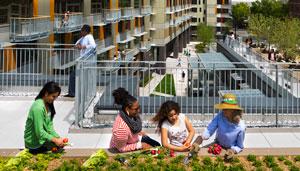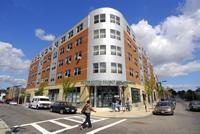Smart Growth and Affordable Housing
Background
A smart growth approach to housing, with compact development, green design and construction, and transportation options, can help communities and their residents protect the environment and create more affordable neighborhoods.
Conventional housing development has contributed to converting rural land at a rate three times faster than population growth1 and a rise in vehicle miles traveled triple the population growth rate.2 Conventional, large-lot, dispersed housing development challenges our ability to maintain and protect air and water quality, as well as local governments' ability to finance and maintain infrastructure including schools, utilities, street networks, and police and fire protection.
 Via Verde, a mixed-income housing development in the Bronx in New York City, is near subway and bus lines. It uses energy 30% more efficiently than comparable buildings, saving residents money. Read more about Via Verde in the 2013 National Award for Smart Growth Achievement booklet. Photo courtesy of David Sundberg/Esto.The location of housing and the transportation options it supports dramatically affect affordability. Dispersed housing often cannot support viable public transit, biking, or pedestrian options, which can make automobile ownership almost a necessity. The true cost of housing, therefore, is the combined cost of housing and transportation.
Via Verde, a mixed-income housing development in the Bronx in New York City, is near subway and bus lines. It uses energy 30% more efficiently than comparable buildings, saving residents money. Read more about Via Verde in the 2013 National Award for Smart Growth Achievement booklet. Photo courtesy of David Sundberg/Esto.The location of housing and the transportation options it supports dramatically affect affordability. Dispersed housing often cannot support viable public transit, biking, or pedestrian options, which can make automobile ownership almost a necessity. The true cost of housing, therefore, is the combined cost of housing and transportation.
- On average, working families spend nearly 60 percent of household income on housing and transportation combined. For the working poor, housing location has an even more dramatic impact: households earning $20,000 to $35,000 and living far from job centers spend 70 percent of their income on housing (33 percent) and transportation (37 percent). For those living in the central city, housing costs are the same, but transportation drops to 22 percent.3
- Location can also contribute to more stable housing values, critically important for households whose homes are their primary asset. For example, centrally located homes with more transportation choices held their value better during the 2007-2008 gas price increase than car-dependent homes in outlying areas.4
Housing construction approaches also determine a home’s affordability.
- Green building materials, techniques, and appliances can reduce energy consumption by an average of 33 percent5 and water use by about 30 percent.6 These savings are significant, as energy costs can be as much as 22 percent of household income after taxes for the lowest-income households.7
- Water savings reduce utility costs for households, but they also reduce demand, vitally important in regions that are growing rapidly yet also suffering from drought. As climate change is projected to increase drought in many areas of the United States, water-efficient development will become even more important.
- Green building approaches contribute to healthier living environments, which can reduce health care needs for children and missed workdays for parents struggling to make ends meet.
 The Egleston Crossing redevelopment in a Boston neighborhood has affordable homes that are highly energy efficient, have water-efficient fixtures, and use techniques to improve indoor air quality. Learn more about the project in the 2008 National Award for Smart Growth Achievement booklet. Photo courtesy of Urban Edge Housing Corporation.Smart growth approaches support the construction of healthy homes using green building techniques and materials in locations with a range of transportation choices. They encourage building a range of housing types to meet the needs of families, young professionals, and the elderly. They encourage investing and redeveloping in existing communities, which uses existing infrastructure and adds amenities in areas that have suffered from disinvestment.
The Egleston Crossing redevelopment in a Boston neighborhood has affordable homes that are highly energy efficient, have water-efficient fixtures, and use techniques to improve indoor air quality. Learn more about the project in the 2008 National Award for Smart Growth Achievement booklet. Photo courtesy of Urban Edge Housing Corporation.Smart growth approaches support the construction of healthy homes using green building techniques and materials in locations with a range of transportation choices. They encourage building a range of housing types to meet the needs of families, young professionals, and the elderly. They encourage investing and redeveloping in existing communities, which uses existing infrastructure and adds amenities in areas that have suffered from disinvestment.
Smart growth strategies are a critical part of our response to climate change. Homes that use energy and water efficiently can help lower-income households cope with economic impacts related to climate change, which could include volatile energy and water prices and supplies. Homes that maintain habitable conditions in extreme heat, power outages, and strong storms are crucial to protecting their inhabitants.
EPA and Other Federal Resources
Some of the materials below have been archived. To find them, click on the "Search EPA Archive" button behind the resource name and type or copy and paste the title of the resource into the search box on the EPA Archive home page.
- Energy Efficiency and Renewable Energy in Low-Income Communities: A Guide to EPA Programs (2016): Helps state and local staff connect with EPA initiatives that can help them expand or develop their own energy efficiency and renewable energy initiatives in ways that benefit low-income communities. Low-income community leaders and stakeholder groups can use the guide to better understand the benefits of participating in EPA initiatives to help community members save energy costs, improve the health and safety of their homes, and protect the environment.
- Residential Construction Trends in America's Metropolitan Regions (2009, 2010, and 2012) Search EPA Archive: Analysis of residential building permits in the 50 largest metropolitan regions to determine where there has been a shift toward redevelopment and in which regions that shift has been most significant.
- Capitol Region Council of Governments, Connecticut (2009) Search EPA Archive: Report from EPA's Smart Growth Implementation Assistance project to help communities use state affordable housing dollars to achieve better environmental results. Local and state decision-makers, developers, and advocates came together to create development guidelines that can help state and local housing programs build mixed-income, mixed-use, green, compact developments with a range of transportation options.
- Smart Growth Guidelines for Sustainable Design and Development (2009): Guidelines developed through the Capital Region Council of Governments technical assistance project that can serve as a checklist for local, state, or regional officials; developers; and community members to ensure that programs, plans, and proposed developments incorporate the elements needed at the location, site, and building levels to result in more sustainable, affordable housing.
- Location Efficiency and Housing Type – Boiling it Down to BTUs, Jonathan Rose Companies for EPA (2011): Examines how a home's location and access to transit affect household energy use compared to using energy-efficiency measures in homes and cars. Creating more energy-efficient communities and buildings would reduce our impact on climate change and save on household energy costs.
Other Resources
The following links exit the site ExitCenter for Housing Policy, A Heavy Load: The Combined Housing and Transportation Burdens of Working Families (2006)
Center for Neighborhood Technology, Housing and Transportation Affordability Index
CEOs for Cities, Driven to the Brink: How the Gas Price Spike Popped the Housing Bubble and Devalued the Suburbs (2008)
ChangeLab Solutions, Preserving, Protecting and Expanding Affordable Housing: A Policy Toolkit for Public Health (2015)
Enterprise Community Partners, Green Communities Program
LISC, Affordable housing resources
Urban Land Institute, Beltway Burden: The Combined Cost of Housing and Transportation in the Greater Washington, DC Metropolitan Area (2009)
1 Heimlich, Ralph E. and William D. Anderson. "Development at the Urban Fringe and Beyond: Impacts on Agriculture and Rural Land" (ERS, Agricultural Economic Report No. 803). June 2001.
2 Ewing, Reid, et al. Growing Cooler: The Evidence on Urban Development and Climate Change. Urban Land Institute, 2008.
3 Center for Housing Policy. A Heavy Load: Combined Housing and Transportation Burdens of Working Families. Exit 2006.
4 CEOs for Cities. Driven to the Brink: How the Gas Price Spike Popped the Housing Bubble and Devalued the Suburbs. Exit 2008.
5 Good Energies. "Greening Building and Communities: Costs and Benefits." 2008.
6 Kats, Greg et al. "The Costs and Financial Benefits of Green Buildings: A Report to California’s Sustainable Building Task Force." Exit 2003.
7 U.S. Bureau of Labor Statistics, U.S. Department of Labor. Consumer Expenditures in 2009. Report 1029. 2011.
